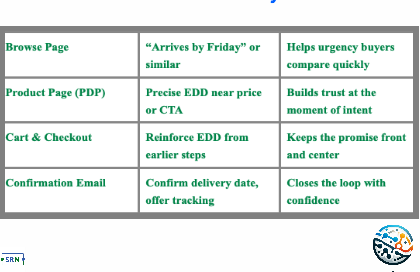How Delivery Date Visibility Impacts E-Commerce Conversion, The Hidden Lever for Sales
While fulfillment speed remains vital, transparent communication of that speed, especially early in the shopping journey, can be a decisive factor in driving conversion and customer satisfaction.
Three out of four shoppers buy with a purpose, and for one in three shopper that purpose comes with urgency, the race against time.
When delivery timing is unclear, customers hesitate or leave.
🤝 Show the estimated delivery date upfront, and you remove friction, build trust, and move them to act. Get it right, and conversion can increase by up to eight percent, all from a simple, visible promise.
Estimated Delivery Dates (EDDs) are the visible promises that tell customers when their order will arrive, before they click “Buy.”
In today’s market:
Switching is easy.
Prices are comparable.
Loyalty is fragile.
What sets one retailer apart is not always price or brand, BUT clarity, especially around when the product will arrive. It is not about being the fastest, but about giving customers a specific date they can count on.
🤯 The Cognitive Cost of Speed
In 2025, nearly forty percent (40%) of retailers use speed (Get it in 2-4 days, or 8-10 days) instead of specific dates.
🚫 STOP…
Calculating speed puts cognitive load on the customer. They have to figure out if four, six, or eight days means business or calendar days. Do holidays count? Should they include today? Too many questions, not enough clarity.
Retailers goal should be to remove barriers for purchases and let customers proceed to “Buy” with clear, actionable messaging.
Retailers should work towards respecting customer needs and anxiety of planning a purchase. In today’s world technology is equivalent to trust.
It’s a handshake.
Dates build on this trust.
That is where Estimated Delivery Dates (EDDs) come in.
When delivery dates are shown early, on browse and product pages, customers move with confidence.
They skip hesitation.
They skip comparisons.
And the impact is real. Brands that surface delivery dates up front see up to a eight percent (8%) lift in conversion. For large businesses, that adds up to billions in additional revenue, without moving the needle on operational costs, just by improving communication.
For retailers and suppliers, it also lowers post-order costs tied to customer service. A clear delivery date or range gives customers a reference point, reducing the need to call and ask, “Where is my order?”
☑️ What Amazon Got Right
Amazon figured this out early.
Their “Buy Now” feature lets customers purchase directly from the product page, with delivery dates displayed clearly and prominently.
In fact, the delivery information takes up more space than the price itself (Exhibit 1 below). That is how much trust matters.
By showing delivery dates as early as the browse page, they reduce friction and make “Buy Now” (their patented technology) work.
But that button only performs because the customer already knows the product will arrive on time and can see it.
That is the trust.
Even when two items are similarly priced, the one with the faster arrival date wins. For deadline-driven shoppers, early visibility is essential.
Here is a snapshot of top brands and how they handle EDDs. Leading multibillion-dollar companies and fast-growing brands display delivery dates clearly, helping customers decide with confidence.
👉 The Wayfair Playbook: How I Scaled Conversion at Wayfair by Putting Delivery Dates Front and Center
At Wayfair, we adopted the same mindset. We made delivery dates visible on browse and PDP pages, before “Add to Cart.”
After testing it across multiple flows, the outcome was clear.
Early visibility leads to more carts, more checkouts, and a more confident customer experience.
At Wayfair, I worked on optimizing delivery communication for millions of SKUs across hundreds of product categories, thousands of suppliers and across hundreds of carriers. What we learned:
Adding delivery dates to browse pages increased click-through rates to product pages by over twenty-two percent (22%).
Speed also played a major role. For every one-day improvement in delivery time, conversion increased by five (5) to seven (7) percent, with gains continuing up to an eight-day advantage.
Showing the date before “Add to Cart” led to a fifteen percent (15%) lift in conversion.
This meant not just showing delivery dates, but showing them in the right place, at the right moment, for the right customer.
✅ Quick Checklist: Where to Show Delivery Dates and Why they Matter
Delivery dates are not a backend feature. They are a front-end decision driver. One out of three shoppers need to know when their order will arrive before they’re willing to buy. And yet, many brands still hide that promise until the checkout screen—or worse, never show it at all.
In short, EDDs are not just a UX improvement. It is a revenue unlock.







